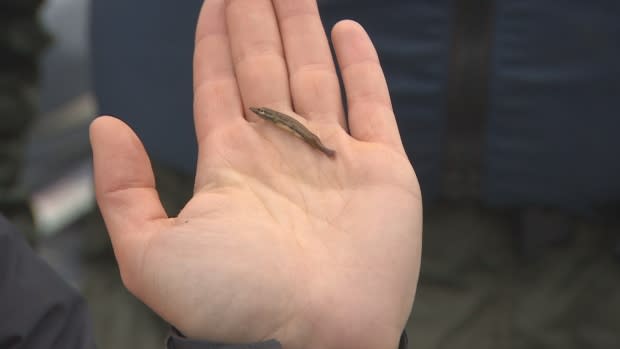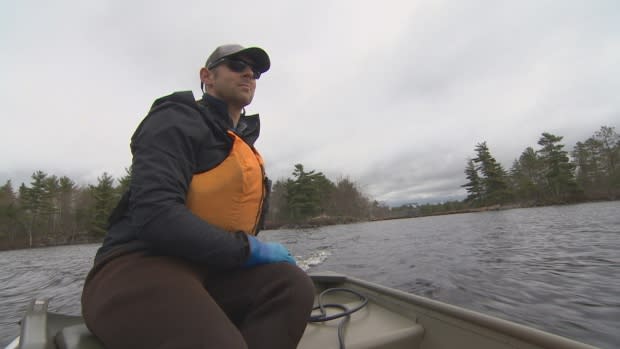Nearing extinction, optimism surrounds future of Atlantic whitefish
After years of setbacks, there is encouraging news this spring for one of Atlantic Canada's most critically endangered species: the Atlantic whitefish. This ancient relative of the Atlantic salmon survives in only three landlocked lakes in the Petite Rivière watershed near Bridgewater, N.S.
"I am feeling much more optimistic than I was last fall," said Paul Bentzen, a Dalhousie University biology professor and geneticist, who has stepped in to help.
Last December, Bentzen took possession of nearly two dozen newly hatched Atlantic whitefish first recovered in May 2018.
Measuring only 2½ centimetres at the time, they were removed for safekeeping to the federal Department of Fisheries and Oceans fish hatchery at Coldbrook in Nova Scotia's Annapolis Valley.
But DFO planned to release them back into the chain pickerel-infested Petite Rivière lake system because it had nowhere else to put them.

The decision alarmed Bentzen, who volunteered to take them to the Aquatron, Dalhousie's aquatic research facility.
Those fish are now 15 centimetres long and thriving.
"It's kind of a happy accident perhaps, but they do well in captivity," said Bentzen. "I mean, that's one of the lucky breaks we have here. They have been eating like crazy and growing like crazy and we think they've doubled their weight since December."
Breeding program in the works?
So far this spring, another 44 newly hatched Atlantic whitefish have been taken from recovery traps in the Petite Rivière system and driven directly to water tanks at the Aquatron.
Bentzen said there are enough fish now to start a breeding program.
"Our plans are to nurture these fish as carefully as we can and basically to make more of them, which means we have to bring them to maturity. We have to spawn them and then we have ... to raise the babies," he said.

"I think we need at least two generations to develop and secure a breeding stock in captivity so we may get our first eggs and our first babies a year from now or next winter really."
However, DFO said "firm plans are not yet in place for the fish at Dalhousie."
In a statement, the department said genetic analysis at Dalhousie will "inform options for raising young in captivity."
DFO and Coastal Action — a conservation group that has partnered in the Atlantic whitefish recovery plan — are also assessing lakes that could be suitable for future introduction of the fish.
Mapping of the Atlantic whitefish genome
When one of the larval Atlantic whitefish died during a transfer at Dalhousie on May 16, it was quickly placed in liquid nitrogen for transfer to Montreal where its DNA will be mapped.
"We are going to sequence the entire Atlantic whitefish genome, which has never been done before," said Bentzen.
The analysis could help scientists identify genes with adaptive importance for traits, such as warmer water temperatures, or anadromy — part of the original life cycle to go to sea and return.
"There will be a lot to learn from the genome," said Bentzen.
Fewer chain pickerel this year
Back on the water, there are other promising signs.
Three lakes — Hebb, Milipsigate and Minamkeke — make up the Petite Rivière watershed.
Chain pickerel have become established in Hebb and Milipsigate lakes. None have been confirmed in Minamkeke Lake.
Coastal Action's Andy Breen said they are seeing far fewer chain pickerel this spring in recovery traps.
Breen points to a tiny larval chain pickerel captured in a rotary screw trap set on Milipsigate.
"This time last year, there seemed to be a lot [of] much larger ones. This year, we seemed to have gotten rid of all of those," he said.
"That may be only the third one we've had this year, whereas last year, we had over 100 chain pickerel in this trap alone."
Electrofishing expanded
In 2018, electrofishing targeting invasive pickerel and smallmouth bass was expanded beyond Hebb Lake for the first time, to Milipsigate and Minamkeke lakes.
Electrofishing involves a flat-bottom boat carrying retractable poles that release electric current into the water, stunning fish.
In Milipsigate alone, nearly 1,200 invasive pickerel and smallmouth bass were removed in 2018.
"We had good success with the boat and removing fish from areas that we had targeted for [Atlantic whitefish] larval collections last year," said Jeremy Broome, a biologist with DFO.
"We were able to hit those areas hard, knowing that there are important areas and we're seeing results this year with very few pickerel being caught in those locations."
Exact numbers of Atlantic whitefish unknown
Upper estimates of the Atlantic whitefish population are in the 400 range, but no one knows for sure how many have survived in the wild.
Only one live adult has been seen since 2014, the year chain pickerel first appeared in Hebb Lake.

The fact that young continue to be recovered is a sign that some adults have survived to spawn.
The level of inbreeding is not known.
Researchers hope the juveniles in the Dalhousie Aquatron come from many different mothers.
Recovery plan
The recovery plan adopted by DFO has three main pillars, said Broome:
Preserving Atlantic whitefish in the Petite Rivière system. That's where electrofishing invasive species comes in.
Restore anadromy — or the ability to run to the ocean. In 2012, a fish ladder was built at the Hebb Lake dam, which for a century blocked the species' access to the Atlantic Ocean.
Expand their range in the wild. That means finding a suitable lake system in Nova Scotia with the right chemistry and — more importantly — is free from invasive predators.
Broome said the work at Dalhousie has offered flexibility to the recovery effort.
"I look at it as giving us options," he said. "As of right now, the fish here in the system, they're in a pretty bad place. And you know we need to be looking elsewhere. And until we have fish in captivity and have the option of breeding them, we don't have options."
MORE TOP STORIES

